Posted by June Underwood on March 6th, 2008
At the request (advice/direction) of my oil painting instructor, Jef Gunn, I have gone out on the streets of Portland to paint. Luckily the weather has been relatively decent, although cold if one is catching morning shadows. But the experience has put me in the midst of the community, and a grand experience it has been.
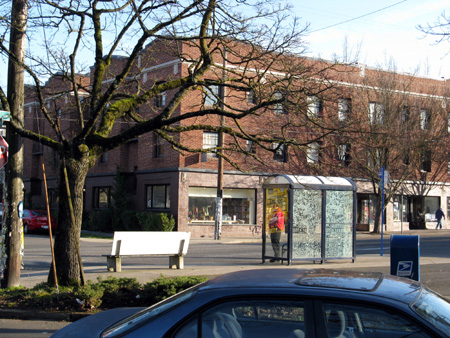
I am discovering that one of the most fulfilling aspects of painting is having the casual onlooker weigh in, discuss the weather, make silly comments or just say “hi.” I didn’t realize until the Basin experience how much having a bit of interaction with the community could mean to me. The Portland pleine aire work that I’ve been doing verifies that social contact enhances the pleasures for me of slapping color on board, smooshing substances around until they come to mean something, and personal ruminations about the view.
more… »
Posted by Steve Durbin on March 4th, 2008
Seems like everybody is making a book these days. Lower prices and improvements in quality have made publish-on-demand an intriguing proposition. Reviews are mixed, but I’ve reached the point where I’m interested in giving it a try. Since I tend to work in projects, there are several bodies of work that are candidates for books. I’ve decided to look first at the smallish number of images in the set I’ve called Winter Water, some of which have been placed on my not up to date web site, or discussed here and there on A&P.
A book is necessarily presented as a linear sequence of pages, though a reader (is it still a reader if there are only photographs?) may not follow that order. Nevertheless, assuming one image per page for maximum resolution, it’s an interesting question to consider what sequence might work best. It’s akin to hanging pictures in an exhibit. As I am neither illustrating a narrative nor providing a guide to Pine Creek Falls in Paradise Valley in late November, I am not bound by the order in which the photographs were made or the physical layout of the falls. Considerations include interesting pictorial relationships, pacing, and the overall impression desired. None of these is at all well-defined, and I come up with a different order every time I sit down to it. I make no claims for the latest version shown below; in fact, I’m asking for your help.
more… »
Posted by Steve Durbin on February 29th, 2008
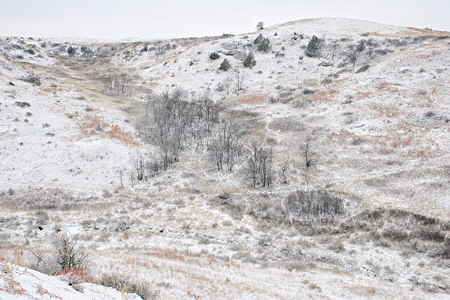
A while ago I posted some first thoughts on personal psychogeography, including the germ of a project involving photography and writing. I’m grateful to comments (from Martha and Lucy) for pointing me to significant related work by Richard Long, Hamish Fulton (beware annoying Flash), and Francesco Careri. These have been helpful to me in formulating my own project, which is, in fact, very different. I am approaching the idea — call it a psychogeographic study — primarily as a photographer, i.e. one interested in making photographs. In contrast, Long and Fulton (and the architect Careri, from the little I know) consider their photographs quite secondary: the walk itself is the artwork.
more… »
Posted by Birgit Zipser on February 27th, 2008
as we are told in yesterday’s headline of the Columbia Daily Spectator reporting on the opening of an HBO documentary reminding us of the long gestation of Christo and Jeanne-Claude’s Saffron Gates in Central Park, New York City?
Or does Saffron spell enthusiasm? Here is my snapshot of Saffron cloth billowing in the wind on a snow-free day, February 2005.

more… »
Posted by Birgit Zipser on February 22nd, 2008
After musing for decade or so on how to capture this solitary stand of cottonwoods growing on a ridge in the dunes, the challenge was met through dérive or drifting.
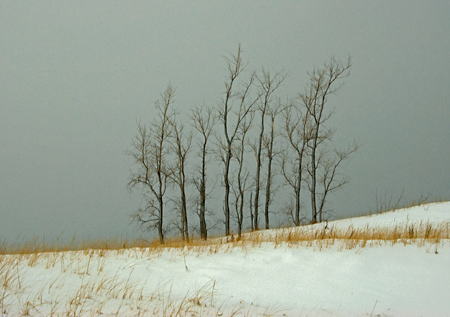
more… »
Posted by Steve Durbin on February 19th, 2008
Among the first images I captured after purchasing my digital camera were made on a trip to the Yucatan peninsula of Mexico. I was drawn mainly by the Mayan ruins there, having had a particular interest in things Maya since a college anthropology class. Though terrific in some ways, photographically the trip was not a success. Although I wrote last week of re-visiting and revising old images, there’s no point if the original lacks merit. I did not know my new equipment well, I didn’t understand picture-making very well, and though I knew I wanted to work in black and white, I hadn’t yet developed an eye for it.

more… »
Posted by June Underwood on February 15th, 2008
The back wall of the Hewitt Downstairs studio at the Montana Artists Refuge is about 15 feet by 20 feet. It was that wall that became the repository for a series of oil-painted panels called The Refuge. The Artists Refuge is in Basin, Montana; The Refuge is oil on canvas, a product of my two-month residency in Basin.
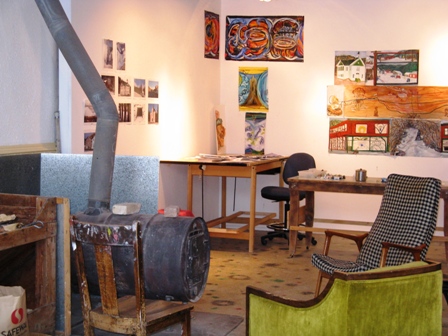
The Refuge is a visual rendition of a psychogeography of Basin, Montana — paintings that recall scenes and feelings arising from that particular place in that particular time and space of my life.
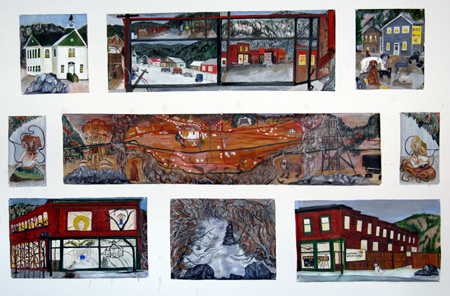
The Refuge, oil on canvas, Approximately 6′ x 10′.
more… »





